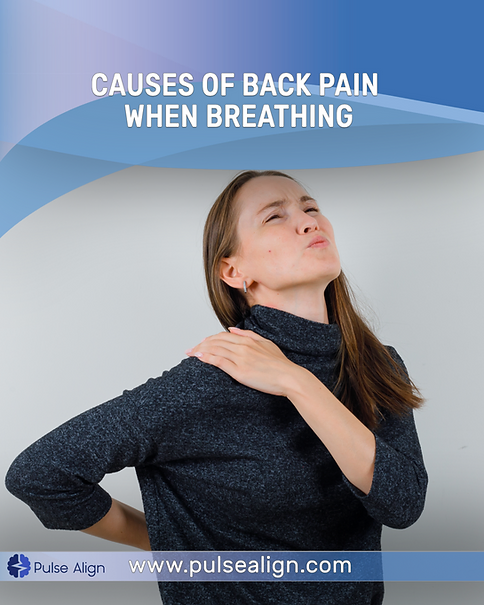Back pain is a common ailment that can manifest in various forms, affecting individuals of all ages and backgrounds. One peculiar manifestation is back pain when breathing, which can be a cause for concern and discomfort. In this comprehensive blog, we will delve into the potential causes of back pain when breathing and explore effective relief tips. Additionally, we will discuss the holistic approach of Pulse Align in addressing root causes rather than just symptoms.
Furthermore, it has been projected that by 2050, over 800 million individuals globally will experience back pain. Consequently, it is imperative to identify the key factors contributing to back pain in order to mitigate its profound impact in the future.
Understanding Back Pain When Breathing
Mechanics of Breathing and the Spine
To comprehend back pain when breathing, it’s essential to understand the intricate relationship between the respiratory system and the spine. The diaphragm, a crucial muscle involved in breathing, attaches to the lower part of the spine. Any disruption in this area can lead to pain when breathing.
Potential Causes of Back Pain When Breathing
- Muscular Strain
- Intense physical activity or poor posture can strain the muscles in the back, leading to pain when breathing.
- Injury or Trauma
- Any injury or trauma to the spine, ribs, or surrounding muscles can result in pain during inhalation or exhalation.
- Spinal Conditions
- Conditions like herniated discs, scoliosis, or spinal stenosis can contribute to back pain when breathing.
- Inflammation
- Inflammation of the pleura (pleuritis) or the surrounding tissues can cause pain with each breath.
Exploring Relief Tips
Conventional Approaches
- Pain Medications
- Over-the-counter or prescription medications can offer temporary relief from back pain when breathing.
- Physical Therapy
- Targeted exercises and stretches can strengthen the muscles and improve posture, alleviating breathing-related back pain.
- Hot and Cold Therapy
- Applying heat or cold to the affected area can help reduce inflammation and ease discomfort.
The Role of Pulse Align in Holistic Well-being
Understanding Pulse Align
- Alignment for Optimal Function
- Pulse Align emphasizes the significance of proper alignment in the musculoskeletal system for optimal function and reduced pain.
- Root Cause Approach
- Unlike conventional treatments that often target symptoms, Pulse Align aims to identify and address the root causes of pain, fostering a sustainable approach to well-being.
Potential Benefits of Pulse Align
- Improved Posture
- Pulse Align focuses on improving posture, which can have a positive impact on breathing and reduce back pain.
- Enhanced Body Awareness
- The system encourages individuals to be more aware of their bodies, promoting mindful movements and preventing strain.
- Integrated Well-being
- Pulse Align recognizes the interconnectedness of physical and mental well-being, offering a holistic approach to pain management.
Conclusion: Inviting Lifestyle Changes and Exploring Pulse Align
In conclusion, individuals experiencing back pain when breathing should consider incorporating lifestyle changes and exploring holistic approaches like Pulse Align. By addressing the root causes and promoting overall well-being, Pulse Align offers a sustainable solution to alleviate discomfort and enhance the quality of life. Embracing a holistic mindset can empower individuals to take charge of their health and experience a natural return to normal function.
References
Ferreira, M. L., de Luca, K., Haile, L. M., Steinmetz, J. D., Culbreth, G. T., Cross, M., … & Mahmoodpoor, A. (2023). Global, regional, and national burden of low back pain, 1990–2020, its attributable risk factors, and projections to 2050: a systematic analysis of the Global Burden of Disease Study 2021. The Lancet Rheumatology, 5(6), e316-e329. https://www.thelancet.com/journals/lanrhe/article/PIIS2665-9913(23)00098-X/fulltext
As the visionary CEO of Pulse Align, François is dedicated to transforming the landscape of pain management and posture health. With a deep-rooted passion for innovation and a commitment to excellence, François leads the team in developing cutting-edge solutions that empower individuals to live healthier, pain-free lives. Under his leadership, Pulse Align has become a beacon of hope and support for those navigating postural-related issues and chronic pain. François brings a wealth of experience in neuromodulation and patient management technologies, combining strategic insight with a compassionate approach to address the unique challenges faced by each individual.




